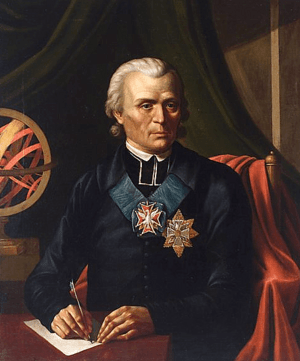Marcin Odlanicki Poczobutt facts for kids

Portrait by Józef Oleszkiewicz
Marcin Odlanicki Poczobutt (born October 30, 1728, near Grodno – died February 7, 1810, in Daugavpils) was a smart Polish-Lithuanian man. He was a Jesuit (a member of a Catholic religious order), an astronomer (someone who studies stars and planets), and a mathematician (someone who studies numbers and shapes). He taught at Vilnius University for over 50 years. He was even the head of the university, called the rector, from 1780 to 1799. There's a crater on the Moon named after him!
Contents
Marcin Poczobutt: A Life of Learning
Marcin Odlanicki Poczobutt was born in a village called Salomenka, close to Grodno. He went to Vilnius University from 1745 to 1751. He also studied at Charles University in Prague. From 1753 to 1808, he taught at Vilnius University.
Studying the Stars
From 1762 to 1764, he studied more in France, Italy, and Germany. This was made possible by Michał Fryderyk Czartoryski. His time at the Marseille Observatory made him want to spend his life studying astronomy. In 1764, he earned his doctorate of philosophy. He became a professor and the director of the Vilnius Astronomical Observatory. This observatory was quite new. Poczobutt worked hard to get modern tools for it.
Leading the University
Even though the suppression of the Jesuits happened in 1773, the observatory was still supported by King Stanisław August Poniatowski. It was even called the royal observatory, and Poczobutt became the King's astronomer. In 1780, Poczobutt became the rector (head) of Vilnius University. This was decided by the Commission of National Education. His job was to change the university. It used to focus on old subjects like philosophy and religion. Poczobutt helped it become a modern school with strong science, medicine, and law departments.
Exploring the Stars: Poczobutt's Discoveries
Marcin Poczobutt often traveled to London. There, he bought special astronomy tools from famous makers like Jesse Ramsden and John Dollond.
Amazing Instruments
He bought a 4-foot transit telescope in 1765. In 1770, he got a 3.5-foot achromatic telescope. He also bought an 8-foot mural quadrant in 1777 and a meridian circle in 1788. Other tools included an octant, an equatorial, two theodolites, and a 10-foot sextant. The observatory was made bigger by architect Marcin Knackfus from 1782 to 1788 to hold all this new equipment.
What He Observed
Poczobutt watched many things in space. He observed solar and lunar eclipses. He also studied comets and asteroids, like Ceres, Pallas, and Juno. He figured out the exact locations (geographic coordinates) of towns in the Grand Duchy of Lithuania, including Vilnius and Hrodna. He also measured the planet Mercury to calculate how it moves. Later, this information was used by another famous astronomer, Jérôme Lalande.
Poczobutt described a group of 16 stars. He named this group Taurus Poniatovii to honor King Poniatowski. Today, this star group is no longer used and is considered part of the Ophiuchus constellation. He wrote down all his observations in 34 large books!
Weather and Recognition
In 1770, he was the first person in Lithuania to regularly measure and record the weather temperature. We still have his records from 1777 onwards. Poczobutt was chosen to be a fellow of the Royal Society in 1771. He also became a member of the French Academy of Sciences in 1778. He received important awards too: the Order of Saint Stanislaus in 1785 and the Order of the White Eagle in 1793.
See also
- List of Roman Catholic scientist-clerics

